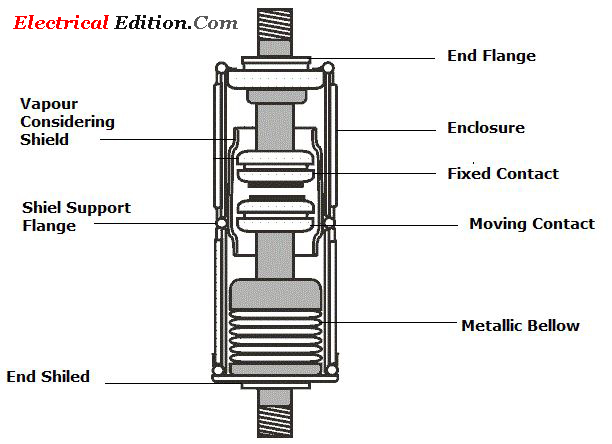A vacuum circuit breaker is the suitable for mainly medium voltage application circuit breaker where the arc quenching takes place in vacuum.The major parts of Vacuum Circuit Breakers circuit breaker are breaker contacts. vapour condensing shields, metallic bellows. end flanges and enclosure.The vacuum pressure inside a vacuum interrupter is normally maintained at 10 - 6 bar.
Construction of Vacuum Circuit Breakers
1. Breaker Contacts
Some of the alloys used as vacuum circuit breaker contacts are copper-bismuth, silver-bismuth, silver—lead and copper-lead. Usually. the contacts have large disc-shaped faces with large stem. The disc faces contain spiral segments so that, the arc current produces axial magnetic field. Such a geometry causes the plasma of the arc ’to move rapidly over the contact surface and hence minimizes the metal evaporation and erosion of the contacts due to are.
2. Vapour Condensing Shield or Metallic Shield or Spotter Shield
These are supported on an insulated housing and are placed in between the contacts and the enclosure such that they enclose the contact region. It prevents the metal vapour (released during arcing) reaching the enclosure and condensing on it. So. condensing of metal vapour takes place on these shields only. Usually, this shield is made of stainless steel.
3. Metallic Bellows
The two ends of metallic bellows of vacuum circuit breaker are welded to lower end flange and the moving contact. They are used to permit the movement of contact inside the sealed construction. They are usually made of stainless steel. In order to perform satisfactory repeated operations. the design of bellows plays a significant role.
4. End Flanges
The end flanges of vacuum circuit breaker support the fixed contact. sputter shield, outer insulating enclosure, metallic bellows and their protective shield. They are made of non-magnetic metal.
5. Enclosure or Outer Envelope
Generally, it is made up of glass because glass is non-porous, impermeable insulating material which can retain high Vacuum. Also, it is quite easy to join it to the end flanges.
Operating Principle,Working of Vacuum Circuit Breakers
The contact faces of vacuum circuit breaker do not have perfectly smooth surfaces instead they have certain micro projections. At the instant just before the contact separation, the entire current through the circuit breaker will be concentrated in these projections as they form the last point of contact. As these micro projections will have a very small area of cross-section, the resistance offered by them will be high. So, these projections will become hot spots due to resistive heating. These hot spots supply sufficient quantity of vapour (or electrons) for the arc formation. So, an arc is drawn between the contacts. In addition to thermionic emission, electron emission can also be due to field emission, secondary emission by positive ion bombardment, secondary emission by photons and pinch effect. From the above, it can be said that the arc electrons and ions Will not come from the vacuum but they are being emitted from the electrodes.
The contacts will release sufficient metal vapour even for very low value of current so that the vacuum arc is stable in order to avoid current chopping. Therefore, the arc current interruption will take place only at current-zero instant. At current zero, the cathode spot disappears within ions and 3 after this the steady state dielectric strength will be recovered quickly. Thus the restriking of arc will not occur.
Applications of Vacuum Circuit Breakers
1. Capacitor bank switching
2. Reactor switching
3. Transformer switching
4. Line dropping.
Advantages of Vacuum Circuit Breaker Over Conventional Type Circuit Breakers
1. Simple construction.
2. Self contained i.e., no need of periodic refilling of gas or oil.
3. Compact size.
4. Low power requirement for making and breaking operations.
5. Pollution free.
6. Long life
7. Non-explosive.
8. Suitable for repeated operating duty.
9. High speed’of dielectric recovery.
10. Silent operation.
11. Low maintenance.
12. Capable of interrupting highly inductive and capacitive currents without restriking.
Tags:vacuum circuit breaker principle,vacuum circuit breaker pdf,vacuum circuit breaker working wikipedia.

